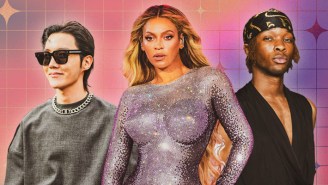With Transformers: Dark of the Moon opening this week, there’s been a lot of talk about Michael Bay’s unapologetic anti-intellectualism, the 3-D craze, and movie audiences’ weak spot for explosions and giant robots fighting each other. In all the hype, we forget what the Transformers story is REALLY about: a quest for Hasbro to sell robot toys that dates back a quarter-century to the TV series debut in 1984.
Yes, as much as we love to think TV is some sort of high art form, it’s basically just a way for companies to advertise their goods and services to you. The way it’s supposed to work for a half-hour show is 22 minutes of programming and 8 minutes of commercials. But businesses quickly found a way around that, and they’ve been essentially airing 30 minutes of advertising to unsuspecting children for decades now. Below are ten of the most blatant examples — with “Transformers” and “G.I. Joe” excluded, because this is the advanced class. Intro to Obvious Examples is down the hall.
“Hot Wheels”
One of the earliest examples of the toy-to-TV transition, ABC’s animated “Hot Wheels” had a vague plot about good guy Jack “Rabbit” Wheeler and his Hot Wheels Racing Club having weekly races against bad guy Dexter Carter, the leader of Dexter’s Demons. The show is still notable for two reasons: it was the first “acting” role for Albert Brooks, who would later write Lost In America and guest star on “The Simpsons” as Hank Scorpio, and it became embroiled in a legal controversy. Toy companies, including Mattel’s rival Topper, began to complain that “Hot Wheels” was basically a half-hour commercial aimed at children, which was illegal. The FCC stepped in and ordered the show off the air, saying, “We find this pattern disturbing…for [it] subordinates programming in the interest of the public to programming in the interest of salability.” This ruling stayed in effect until 1984, when, according to the New York Times, “there [were] no limits of any kind on the amount of advertising stations can broadcast.” Which led to a lot of this:
“Robotix”
In 1984, Milton Bradley debuted two lines of toys, Transformers and Robotix, that were quickly made in to TV shows. They both had roughly the same story—with “Transformers,” it’s Autobots vs. Decepticons and humans get in the way; with “Robotix,” it’s Protectons vs. Terrakors and humans get in the way—but only one is still mentioned today. And makes hundreds of millions of dollars for an egomaniac of a director and keeps Shia LaBeouf a household name. I honestly think it’s because the word “Transformers” is cooler sounding than “Robotix,” which just reminds people of Lyme disease. Robotic Lyme disease, but Lyme disease nonetheless. Fifteen six-minute shorts aired on TV as part of “Super Sunday,” and they were combined into a poorly thought out film in 1987.
“Jem and the Holograms”
“Jem” was another “Super Sunday” short, along with “Inhumanoids” and “Bigfoot and the Muscle Machines” (which had NOTHING to do with Sasquatch but did star a monster-truck driver named Yank Justice), and it’s probably the most infamous of the group. I’d like to say I did my part when I listed Jem, sans Holograms, as the sixth sexiest cartoon musician of all-time, but really the credit goes to Griffin-Bacal Advertising, who Hasbro hired to create the show in 1984. They did such a good job that the short got its own full-length show and has since been released on DVD. With the success of “Transformers” and “G.I. Joe: The Rise of Cobra,” it’s likely a “Jem” movie will be made soon.
“Jayce and the Wheeled Warriors”
Every episode of “Jayce,” a show developed by J. Michael Straczynski, who would later become the show runner for “Babylon 5,” began with: “Thundering across the stars to save the universe from the Monster Minds. Jayce searches for his father to unite the Magic Root and lead his Lightning League to victory over the changing form of Saw Boss. Wheeled Warriors explode into battle—Lightning strikes!” Those are all words, in English, and yet I understand nothing.
Produced by DIC Entertainment, the same company that gave us “Inspector Gadget” (and its middle school counterpart, “Inspect Her Gadget”), “Jayce,” based on a Mattel toy line, ran for 65 episodes and still has an oddly devoted fan base. There’s even fan fiction and art, although when a main character is named Herc Stormsailor, it’s tough to tell the actual scripts from the fan-made stories.
“My Little Pony”
What do Danny DeVito, the voice of Bart Simpson, Felix Unger, and Lili von Shtupp have in common? They all lent their voice to My Little Pony: The Movie, based on the 100 million-plus selling Hasbro toy line (DeVito played the Grundle King). It bombed at the box office, but rather than take Lickety-Split and Morning Glory (voiced by Martin Prince) to the glue factory, a TV series, called simply “My Little Pony,” was rushed into production. Then another in 1992, “My Little Pony Tales” (where the ponies, including one named Bright Eyes, now lived like humans, rather than in the original’s made-up Dream Valley), and another, 2010’s “My Little Pony Friendship Is Magic,” which has since become a 4chan-approved, not-totally-ironic meme.
And it’s all worth it for the Wired article on Bronies.
“Glo Friends”/”MoonDreamers”/”Potato Head Kids”
Each episode of the original “My Little Pony” was 10 minutes long. To fill out the other 10 minutes, an “episode” of “Glo Friends,” “Potato Head Kids,” or “MoonDreamers” would air. “Glo Friends” expanded the canon of the original Glo-Worm, teaming him up with Glo Prayerbug and Glo Skunkbug, while “Potato Head Kids” answered the age-old question about what would happen if two spuds f**ked (the answer: their kids would look like McNuggets and one would be voiced by Breckin Meyer). I refuse to comment on “MoonDreamers” and its nausea-inducing plot descriptions: “Whimzee accidentally creates a fuzzy little character called a Dreamkin, which comes to life when it pops out of the Dream Machine…”
(Shows like that make me really hate the world, for obvious reasons, and also myself, because I’ve come up with ideas like that before but no one’s ever taken the bait. When I was a kid, I created stories based on the self-created character of Wart Man. Sure, he wasn’t fuzzy and cute, but neither were the Battletoads and I’m sure someone became a millionaire out of those anthropomorphic amphibians.)
So really, it was just 30 minutes of advertising.
“Rubik, the Amazing Cube”
In an interview with Ernő Rubik, who created a cube you solve with your main finger, the Hungarian inventor said, “Space always intrigued me, with its incredibly rich possibilities, space alteration by [architectural] objects, objects transformation in space, movement in space and in time, their correlation, their repercussion on mankind, the relation between man and space, the object and time. I think the Cube arose from this interest.”
How proud he must have been of “Rubik, the Amazing Cube,” an ABC Saturday morning cartoon that premiered in 1983 (with a theme song by Menudo). The show starred Rubik, a Smurf-like Yoda who could talk and fly and make people invisible. He was discovered by the Rodriguez family after the crate he was trapped in fell off a gypsy wagon. Rubik and the kids solved crimes every week, constantly foiling the plots of Jaws and the Sharks and the Mysterious Man. The Cube was a pretty flimsy hero—even the slightest breeze would twist Rubik out of alignment, and he’d lose his magical abilities—but the ridiculousness of the show made it more enjoyable than the pandering “Pac-Man,” which “Rubik” was teamed with from 1983-1984. “Pac-Man” took too much artistic license—I mean, giving Ms. Pac-Man a name, Pepper? Call me old-fashioned, but I like my women nameless.
“The Magilla Gorilla Show”
He really was a gorilla for sale. “The Magilla Gorilla Show” was a Hanna-Barbera production, but the program was blatantly sponsored by Ideal Toys, manufacturers of Mouse Trap. How blatant? At the end of every episode, Magilla would say that the show “has been presented by Ideal Toys. They’re wonderful toys! They’re ideal! *laughs* Get it?” Although the TV show technically came at the same time, if not before, as the products, the intent of both “Magilla” and, later, “The Peter Potamus Show” was still as obvious as “BUY MY BOOK”.
“The Twisted Whiskers Show”
Even with the existence of God’s Learning Channel and Smile of a Child TV, my money’s still on The Hub as the worst American TV channel. It’s a joint venture between Discovery Communications and Hasbro, used largely to broadcast programs based on products from the toy and board game distributor. But they also air shows about merchandise from other companies. For instance, the first program on The Hub, on October 10, 2010, was “The Twisted Whiskers Show,” based on the creepy wide-eyed characters created by American Greetings, the masterminds behind Strawberry Shortcake. On top of the obvious awfulness of a show created by a business that sells gift wrap and greeting cards, “Twisted Whiskers” has the WORST theme song: a group of whiny kids yell “meow” over and over again, while a fake dog barks an awful fake bark, topped off by the scratchiest guitar solo in music history. Really makes you appreciate the unfairly maligned theme to “Rickey Rocket.”
“Winky Dink and You”
Winky Dink was the titular mischievous character of TV’s first interactive show, created by Harry W. Prichett and Edwin Brit Wyckoff. On Saturday mornings, beginning in 1953, host Jack Barry (who you may know from the movie Quiz Show) would implore kids to move their polio-ridden bodies over to the TV, take out their Winky Dink Kits containing a Magic Window (static plastic) to put over the screen and a number of crayons, and help their star-headed hero escape danger by connecting dots. It’s a brilliant idea, made even more genius by charging 50 cents per kit (Prichett and Wyckoff first met at an advertising company).
In 1957, “Winky” went off the air, but was revived in 1969, with a syndicated version of the show. It lasted for four years, until parents starting complaining about their children drawing all over the screen. The other reason: TV was now, of course, in color, and consumer groups were growing weary of the possibility of radiation emanating from the boob tube. (And yes, while it’s true that Winky Dink: The Show came out at the same time as Winky Dink: The Product, it’s included because not enough lists end with children getting poisoned with radiation.)






